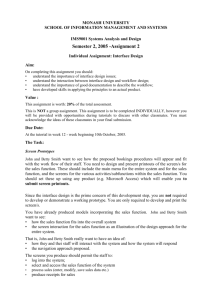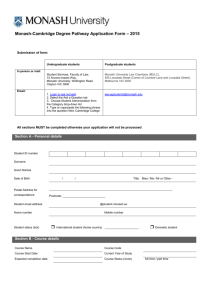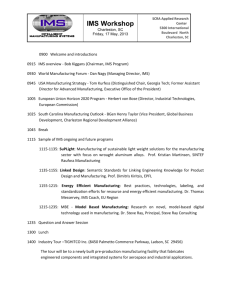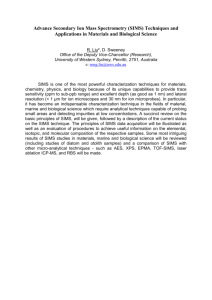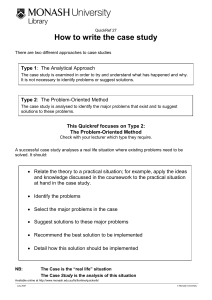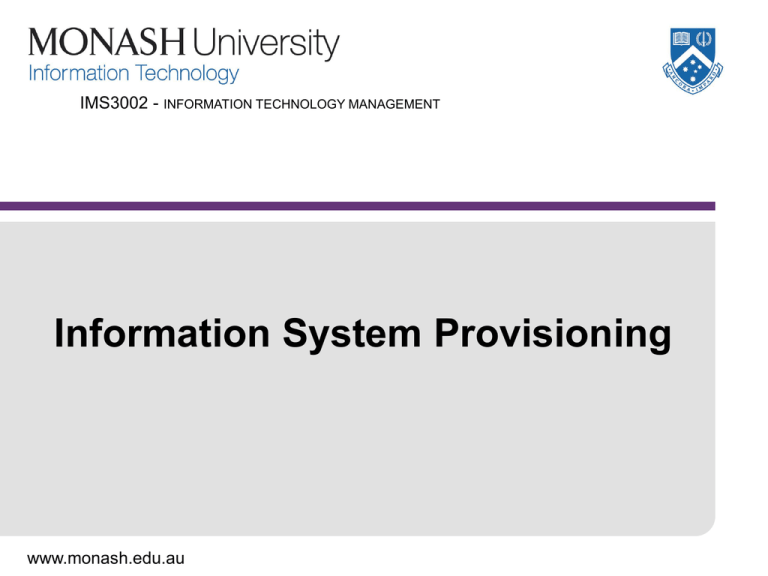
IMS3002 - INFORMATION TECHNOLOGY MANAGEMENT
Information System Provisioning
www.monash.edu.au
Learning Objectives
• Understand the major elements of
information technology provisioning in
organizations today.
IMS 9043 www.sims.monash.edu.au
2
Information Systems Provisioning
• systems provisioning refers to the set of processes used
by IT managers in order to fulfill an organisation’s IT
requirements
– identification of an applications requirement
– definition of the problem
– selection of the appropriate approach to providing a
solution
– completion of the selected processes
– installation of the solution as operational software
IMS 9043 www.sims.monash.edu.au
3
Systems Provisioning
•
we use the term “provisioning” because systems may be
provided in a range of different ways - not just as new
developments
•
systems development remains a major focus but it is important
to remember that development is just one alternative way to
obtain a new system
•
IS skills have been defined and developed in the context of new
systems development, but note that:
> systems development skills are relevant in all cases
> systems analysis skills are particularly important
IMS 9043 www.sims.monash.edu.au
4
Provisioning Methods
• Systems Development
>
>
>
>
>
Traditional approach (formal SDLC)
Rapid systems development
RAD (JAD)
Prototyping
End user systems development
• Systems Purchase
>
>
>
Purchase of a packaged solution
ERP a special case
Purchase and customization
IMS 9043 www.sims.monash.edu.au
5
Historic function-based systems structure
eg - credit checking
eg - invoicing
Business Process
Supporting
Systems
Function
1
Function
2
Function
3
System
1
Databases
debtors database
(customer info)
credit risk database
(customer info)
system interfaces
IMS 9043 www.sims.monash.edu.au
6
Traditional Developments
•
•
the traditional approach was to build a system to meet specific
user requirements
advantages included
– installation of “purpose-built” solutions which were specific
to organizational requirements
– being able to utilize and retain organizational knowledge
•
risks with traditional developments - they can
– be expensive, time-consuming and quite risky to build and
install
– suffer from “scope creep”
– require skills in short supply
– require high levels of maintenance
IMS 9043 www.sims.monash.edu.au
7
Systems Development
• “software development remains an individual craft
lacking in solid measurement systems, and based on
weak theoretical foundations”
method cannot ensure
success
• “it is humanly impossible to control large projects” the
more complex the project the less easy it is to keep to
schedule/ budget
• these comments are from practice-oriented guidelines
and indicate the extent to which IT project management
remains a discipline heavily reliant on “gut feel” and
experience
IMS 9043 www.sims.monash.edu.au
8
Information Systems Integration
• a key question in IS is that of “integrated systems”
• an integrated systems structure works off
–
–
–
–
standard
standard
standard
standard
data structures
data definitions
process definitions
business rules
• many theorists misunderstand the complexities involved
and dramatically underestimate the complexity of these
issues
IMS 9043 www.sims.monash.edu.au
9
Redesigned Process Structures
(with integrated systems support)
Business Process
Action
1
Action
2
Action
3
Sharable Automated Business Functions
Integrated Corporate Databases (common definitions)
Integrated Technology Infrastructure
IMS 9043 www.sims.monash.edu.au
10
Benefits of Systems Integration
• standardized work practices/processes
– simplified training requirements
– easier introduction of new staff to the
organization
– interchangeable staff
– standard customer interface
– simplified management processes
– simplified change management
– reduced system redundancy
– economies of scale
IMS 9043 www.sims.monash.edu.au
11
Benefits of Systems Integration
• standardized data structures and definitions
– reliable data
– consistent management information
– consistent reporting formats and processes
– “single-point” system changes
– improved communications
IMS 9043 www.sims.monash.edu.au
12
Integrated Information Systems
• “note that there are no ‘disadvantages’ to
integrated functional systems. It’s
amazing that more companies didn’t have
the foresight to design integrated
systems”
– (Mike Rewald - quoted Turban, McLean & Wetherbe
p371)
IMS 9043 www.sims.monash.edu.au
13
Systems Integration
• there has been no really definitive research into
systems integration, but a large company could
have ~ 200 data entities and 5-6 major processes
(plus many sub-processes) to consider when
planning a systems integration activity
• change is the biggest enemy of large-scale systems
planning - organizational data and process
requirements reflect changes in the business
environment and are therefore not stable
IMS 9043 www.sims.monash.edu.au
14
System Provisioning:
1. Project Management - Development
– good IT management consists in being aware
of the critical issues and focusing on managing
them well
IMS 9043 www.sims.monash.edu.au
15
Methodologies
• what is a methodology?
– an organized collection of methods and techniques
comprising a way to deliver a required output
• why is a methodology?
– the provision of an expert “shell” to guide actions
• does a methodology impact on the need for experience
and/or specialised skills?
IMS 9043 www.sims.monash.edu.au
16
SDLC (Waterfall)
Initiate
Systems
Analysis
Systems
Design
Program
Dvt
System
Testing
Implement
Maintain
IMS 9043 www.sims.monash.edu.au
17
Rational Unified Process
Phases
Process Workflows
Inception Elaboration
Construction
In an
iteration, you
walk through
all workflows
Transition
Business modelling
Requirements
Workflows
group
activities
logically
Analysis & Design
Implementation
Test
Deployment
Supporting Workflows
Configuration Mgmt
Management
Environment
Preliminary
Iteration(s)
Iter.
#1
Used with permission, Copyright 1998 Rational Software, all rights reserved
Iter.
#2
Iter.
#n
Iter. Iter.
#n+1 #n+2
Iter.
#m
Iter.
#m+1
Iterations
IMS 9043 www.sims.monash.edu.au
18
a Good Systems Development
Methodology
• provides a checklist of required actions
• identifies appropriate sequences of actions
• is more like a set of heuristics (rules-of-thumb) than a set
of laws
• focuses on deliverables as much as processes (some
new methodologies emphasise deliverables more than
processes)
IMS 9043 www.sims.monash.edu.au
19
Systems Development
• during the life of a development project, managers
should visit (revisit) the following issues at all critical
review points (review points may be at the start or
finish of methodology stages, or accompany the
production of specific major deliverables)
– economic justification
– resource allocation
– the adequacy of the quality control processes in place
(quality reviews and walkthroughs)
– risk assessment
– progress reviews
IMS 9043 www.sims.monash.edu.au
20
Managing Systems Development
• the following is a brief overview of the
pragmatics of managing systems development
NB:
– managers have to deal with complex, partially
abstract products
– reliable precedents to provide the basis for
estimating are hard to find
– the problems stem from a form of “combinatorial
explosion”
• the three easy variables of project
management…...
IMS 9043 www.sims.monash.edu.au
21
The Three Key Variables
• functionality
– effectiveness of new system: what it can do
• resources
– money, people, machinery expended in
development
• time
– hours spent
IMS 9043 www.sims.monash.edu.au
22
Managing the three variables
• ideally a project manager will retain a
substantial degree of project freedom
• “fixing” time, resources and functionality is a
management recipe for disaster
• effective project management requires the
ability to allow at least one of the key variables
to vary
IMS 9043 www.sims.monash.edu.au
23
Systems Development - Resources
• managing resources
– software products including languages,
development aids, DBMS
– hardware including processing platforms and
networks
– money
– people including developers, user analysts and
support staff
IMS 9043 www.sims.monash.edu.au
24
Systems Development - Time
• managing time
– usually significantly constrained in practice
– the 95% complete syndrome has to be
accommodated
– 1 year is usually the maximum length of time for
which reasonably reliable estimates can be made in
practice (in many cases, forecasts are accurate for a
lot shorter period)
– despite that, IS managers must have forecasts
which are as accurate as possible
– milestones etc. must be set to pace progress
IMS 9043 www.sims.monash.edu.au
25
Systems Development - Time
• when the timeframe doesn’t fit the time required
– one view is that if the timeframe won’t shift, something
else has to give
– a contrasting view is that there is a general tendency
to fit the work to the timeframe rather than the reverse
> Parkinson’s Law: “work expands to fit the time
available to do it”
> Gersick’s Law: “there is a transition point where
having lots of time becomes being short of time”
> Human propensity for “muddling through” despite
normal predictions
– the only solution is high-quality estimating plus tight
management
IMS 9043 www.sims.monash.edu.au
26
Systems Development Functionality
• managing functionality
– functionality is the area of greatest uncertainty in any development
project
– functionality must be accurately documented and agreed
– differences in understanding can surface quite late - one of the
strengths of the formal SDLC is the emphasis on user agreement
– the later the problems surface, the more expensive they are to fix
(“bandaid” solutions are why there are problem areas in most
completed applications)
– reducing functionality is the basic IT management contingency
strategy...
IMS 9043 www.sims.monash.edu.au
27
Some Notorious IS Problems
• controlling scope creep
• documentation
• estimating
• risk management
IMS 9043 www.sims.monash.edu.au
28
“Scope Creep”
• the tendency for the scope to increase because
– some requirements were overlooked during the
early stages
– new possibilities are revealed as the project
progresses and the role of technology becomes
clearer
– the processes of analysis and design help users
to “frame” the problem better
– problems of mutual understanding surface and
have to be resolved
IMS 9043 www.sims.monash.edu.au
29
Documentation
• a lack of adequate documentation is a frequent issue with
information systems
• the major problems with documentation are
– maintaining its accuracy and currency when system
changes are being made is difficult (unlike other
engineering disciplines, many changes are made
directly to the system rather than first documented)
– much documentation is meaningful only to the original
system developers, and as staff changes occur the
motivation to update the documentation weakens
– time pressure
IMS 9043 www.sims.monash.edu.au
30
Estimating
•
perhaps the most problematic area in IT management
– experience is vital but relevant experience takes time to acquire
– estimates need to be revisited as frequently as possible: the key to
reliable estimates is constant revision
– estimates should be prepared on a staged basis (ie first up to system
requirements, then for delivery)
– the relationship between people and progress is not linear
> the “mythical man-month”
•
formal estimating methods
– LOC estimating
– function point estimating (ASMA)
– defect identification and correction rates
•
“defensive” (contingency-oriented) estimating is good practice
IMS 9043 www.sims.monash.edu.au
31
Risk Management
•
managing risk
– the objective is to understand and manage the key risk factors
– progress is measured according to whether the total level of risk is
falling
•
major risk areas
–
–
–
–
–
–
–
–
clients
management skills
technical skills
application characteristics
hardware requirements
system software requirements
project importance
quality processes are discarded as timeframes contract
IMS 9043 www.sims.monash.edu.au
32
Managing Systems Development
• IS project management remains an art rather than a
science
• automated aids
– can be very useful for keeping track of progress
– can assist with estimates and timetabling
– are not a substitute for common-sense and attention to
detail
> ie many automatically generated timetables and
project charts have a very bad signal-to-noise ratio
– “sanity” checks are critical
IMS 9043 www.sims.monash.edu.au
33
System Provisioning
2. Purchasing systems
The Argument for Purchase:
• IT is not a “core” organizational competence
– which means that?
• if an organization is not an IT company, why
should it build or even manage its own
applications?
• but even when purchasing software, it is arguable
that full-scale systems analysis should be conducted
within the purchasing organization anyway
IMS 9043 www.sims.monash.edu.au
34
Purchasing Systems
• we are living in an increasingly automated and
systematized world
• this is even more true of the business world than the
world in general
• virtually all business processes are highly automated
• relatively standard “solutions” now exist for many
business processes including
– general ledger
– financial accounting
– personnel systems
– materials supply and inventory management
– telemarketing
IMS 9043 www.sims.monash.edu.au
35
Purchase versus Build?
• in simple terms, the question is whether to
change the system or the organization
• BUT using systems to drive major
organizational changes is a risky proposition
IMS 9043 www.sims.monash.edu.au
36
Managing Vendor Interactions
• criteria for evaluating a candidate software package
include those relating to the vendor
–
–
–
–
–
–
–
–
reputation
organizational size and market presence
support
expertise
comparison sites
guarantees
upgrades
customisation support policy
IMS 9043 www.sims.monash.edu.au
37
Customization
• this is where a company buys a packaged solution but wishes to
make changes & retain some of the organization’s own “flavor”
– customization requires the establishment of a systems
development project
– >10% change is usually high-risk and very difficult to manage in
practice
> the calculation is difficult because it is usually very difficult to
tell what else will be affected once you start making changes
> scope-creep is very important here because of the tendency
for users to prefer their own way of doing things
IMS 9043 www.sims.monash.edu.au
38
Controlling Customization
• it is extremely hard to control the effects of customization,
irrespective of scope creep
• it is difficult to see the full ramifications of making a change
to the visible outputs of a package
• for instance, changes to data items can impact on database
design, and lead to radical changes in data structures and
definitions (eg - the customer file/entity)
• once work on customization has commenced, developers
frequently find that one thing is connected to another (hipbone connected to the thigh-bone) and that change begets
change
– changes amounting to more than 100% of the original code
have been recorded
IMS 9043 www.sims.monash.edu.au
39
Risks of Customization
• many of the greatest benefits of buying
packages are lost
–
–
–
–
support arrangements
package-related technology upgrades
software enhancements
reliability and performance guarantees
IMS 9043 www.sims.monash.edu.au
40
Assignment 1
•
•
•
•
•
•
focus
research and preparation
organizing
writing
citations and references
individual topics
IMS 9043 www.sims.monash.edu.au
41
Assignment Focus
• facts are only meaningful from some point of
view
– ie : there is no point to the mere recitation of
events despite the way I was taught history
– this is true of “real” science as much as the
social sciences (eg - the splitting of the atom)
IMS 9043 www.sims.monash.edu.au
42
Assignment Focus
• the first step in an assignment of this type is
to decide the approach you wish to take to
the topic
–
–
–
–
–
–
analytic
polemical
theoretical
look at one case or several
review and summary of literature
do not worry about disagreeing with authorities
(even the lecturer)
IMS 9043 www.sims.monash.edu.au
43
Research and Preparation
• literature search
–
–
–
–
–
library
specialised indexes (academic periodicals)
popular press (newspapers, magazines)
internet
NB - record all sources found for the bibliography
(reference list)
• personal experience may be relevant in some cases
IMS 9043 www.sims.monash.edu.au
44
Research and Preparation
• from your chosen perspective (see previous
overhead) review and analyse the material you find
• summarise your findings so you are clear on the
general direction your assignment will take
IMS 9043 www.sims.monash.edu.au
45
Organizing the Assignment
• all assignment submissions benefit from careful
organization
IMS 9043 www.sims.monash.edu.au
46
Organizing the Assignment
• develop a structure in outline before commencing
(eg)
– Introduction and overview
– explanation of your
perspective/orientation/aims/objectives
– detailed discussion of topic (including theory
where relevant)
– supporting and conflicting opinions
– clear statement of your position (opinions) on the
topic
– conclusion (summary)
IMS 9043 www.sims.monash.edu.au
47
Writing
•
•
•
•
be clear about what you are trying to present
be concise (don’t waffle to make up the word-count)
avoid too much repetition in the body of the text
use short sentences for the most part
• NB - it is clear in many assignments that the student has never
got round to clarifying his/her own goals - the reader reaches the
end of the assignment without knowing what was intended to be
the point
IMS 9043 www.sims.monash.edu.au
48
Citations and References (1)
•
citations in the body of your submission should be made as follows
(for books or articles)
– (author year, page)
– (Gould 1999, 24)
– do not use footnotes
•
book references
– Gould, S. 1999. Leonardo’s Mountain of Clams and
the Diet of Worms. Vintage.
•
article references
– Kell, M. 1995. “Pulling the plug: software project
management and the problem of project escalation”,
MIS Quarterly, December.
IMS 9043 www.sims.monash.edu.au
49
Citations and References (2)
•
the same model can be used for website references if there is an
author and a title
– Kell, M. 1995. “Pulling the plug: software project
management and the problem of project escalation”,
www.whatever, date accessed.
•
if there is no author or title listed then for the reference list have
– www.whatever. 2001. website name, date and time
accessed.
– in the body of the text the citation should be in the
form (website-name, 2001).
IMS 9043 www.sims.monash.edu.au
50
Citations and References (3)
•
when to cite
– if you are stating something and want to say that it is
supported by a particular authority - eg
> the theory of punctuated equilibrium is now widely
accepted by evolutionary theorists (Gould 1999)
– if you quote something directly
> “a yearning for the good old days infects us all,
even though such times never existed outside our
reveries” (Gould 1999, 339).
– if you paraphrase something
> Gould suggests that everybody may hanker after
past pleasures (Gould 1999).
IMS 9043 www.sims.monash.edu.au
51
Assignment Topic – System Failure
IMS 9043 www.sims.monash.edu.au
52


